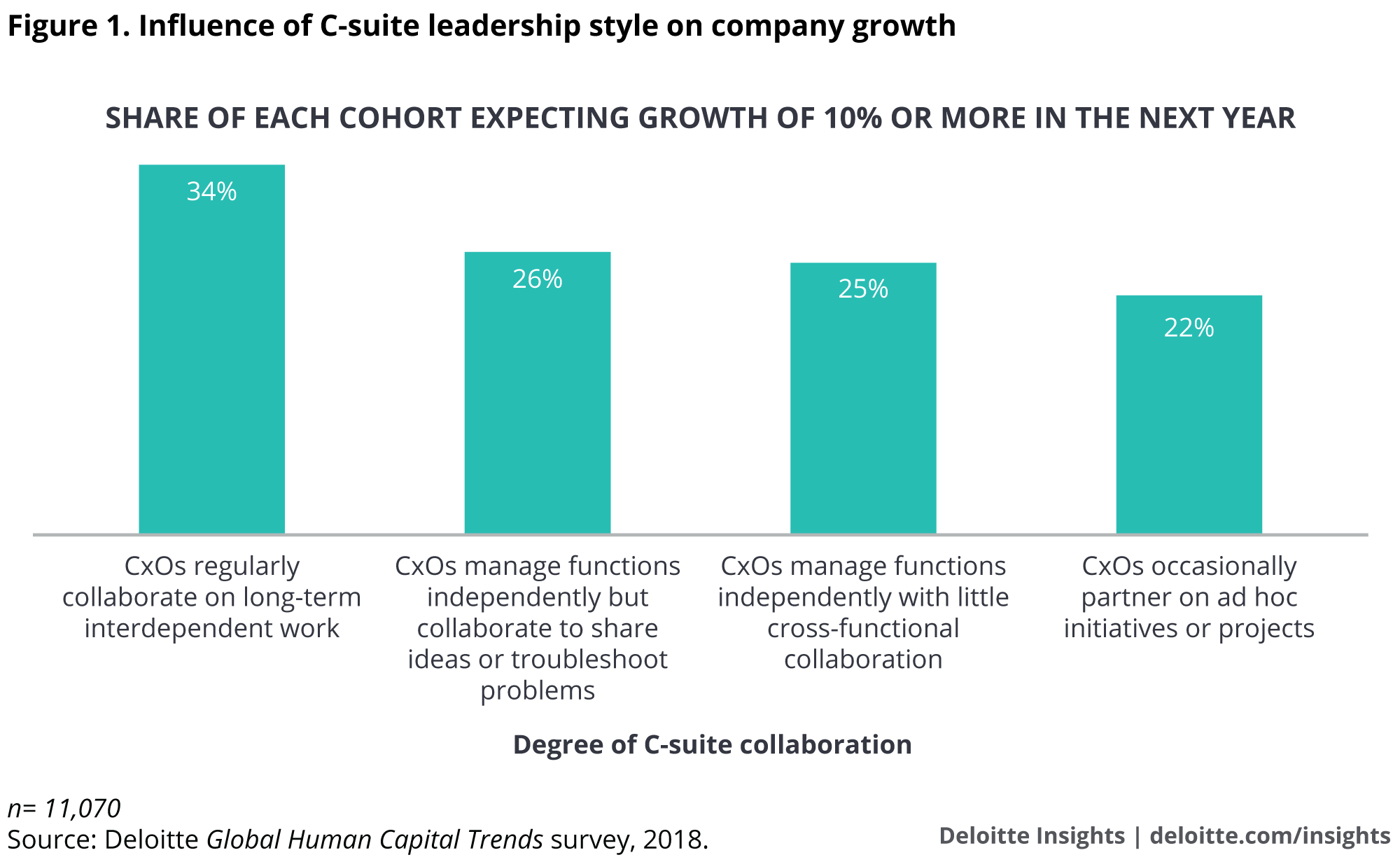
The symphonic C-suite: Teams leading teams 2018 Global Human Capital Trends
28 March 2018
Senior leaders can’t afford to work in silos in today’s complex, dynamic environment. The goal is to act as a symphony of experts playing in harmony—instead of a cacophony of experts who sound great alone, but not together.

Teaming reaches the C-suite
Learn more
View 2018 Global Human Capital Trends
Explore the infographic
Watch the video
Read the press release
Download the full report or create a custom PDF
As the business environment becomes more competitive and digital disruption continues, organizations have become more team-centric, networked, and agile. While these approaches are taking hold in sales, operations, and other functional areas, a big problem remains: The C-suite must change as well. Rather than behave as independent C-level functional experts, the C-suite itself must now operate as a team. We call this trend the “symphonic C-suite,” and our respondents viewed it as the most pressing human capital issue facing organizations today.
In the last two years of our global research, the most important human capital trend identified by our survey respondents has been the need to break down functional hierarchies and build a more networked, team-based organization. This year, this trend has reached the C-suite. Senior leaders now realize that they must move beyond their functional roles and operate as a team. In this new construct, C-suite executives combine business unit and functional ownership with cross-functional teaming to run the organization as an agile network.
The urgency around this issue is clearly reflected in our survey results. Fifty-one percent of the respondents we surveyed this year rated “C-suite collaboration” as very important—making it the most important issue in our 2018 survey—and 85 percent said that it was important or very important. Additionally, we found that respondents at organizations with the highest level of CxO cross-collaboration were the most likely to anticipate growth of 10 percent or more. Stunningly, however, 73 percent of respondents told us that their C-suite leaders rarely, if ever, work together on projects or strategic initiatives.
C-suite collaboration correlates with higher growth expectations
Respondents from organizations where C-suite execs regularly collaborate on long-term interdependent work were the most likely to anticipate growth of 10 percent or more.

Explore the data further in the Global Human Capital Trends app.
The message is clear: Senior leaders must get out of their silos and work with each other more. To navigate today’s constantly changing business environment and address cross-disciplinary challenges, a company’s top leaders must act as one.
We call this new, collaborative, team-based senior executive model “the symphonic C-suite.” Like a great symphony orchestra, a symphonic C-suite brings together multiple elements: the musical score, or the strategy; the different types of instrumental musicians, or the business functions; the first chairs, or the functional leaders; and the conductor, or the CEO. In this model, C-suite members not only lead their own area of responsibility, but also collaborate with other functional leaders, work on teams that affect the enterprise’s strategic direction, and influence and inspire networks of teams throughout the organization. In short, the goal is a symphony of specialized experts playing in harmony—instead of a cacophony of experts who sound great alone, but not together.
A turning point in C-suite evolution
This wasn’t always the way C-suites behaved. In the 1800s and early 1900s, the CEO stood alone at the top, making most of the important decisions and delegating responsibility to functional managers in the business. This model was later extended to create a series of "specialist heroes,” each with a “C” in his or her title: chief financial officers, chief information officers, chief human resources officers . . . the list goes on and on. Each was given responsibility to “own” his or her domain, operating under a “divide and conquer” model.1
With this increased specialization, however, a new dynamic emerged: The individual CxOs did not, as a rule, work closely together. This made sense in a relatively static, predictable business environment where most problems had readily identifiable root causes, were limited in scope, and required deep functional expertise to solve.
But the current business environment is a far cry from what it was in the 1980s, which saw a huge increase in the number and type of functional C-suite roles.2 Frequent marketplace disruptions, a global economy, and the accelerating rate of technological change mean that the problems companies now face are more difficult, more complex, and more multidimensional than ever. More and more problems are of the “wicked” variety—problems with multiple roots and drivers that cannot be effectively solved by one party working alone.
In a dynamic environment demanding both cross-disciplinary collaboration and deep functional expertise, operating as a symphonic C-suite makes a great deal of sense, allowing leadership teams to tackle issues that no single function can satisfactorily address. For instance, today’s digitally savvy, well-informed consumer is demanding that businesses deliver not only good products, but a great end-to-end customer experience—from the time he or she becomes aware of a product through the end of the product’s life cycle. Rising to this challenge demands that organizations work across functions to understand and fulfill customer needs at every touch point.
As another example, consider a company’s need for agility in navigating rapidly shifting markets, technologies, competitors, and customer expectations. If an executive team does not operate as an integrated decision-making unit, they risk moving too slowly to align the organization with the demands of its time and place. HP’s decision to split its businesses, for example, was made in an integrated fashion among its C-suite—which allowed the company to rapidly respond to shifting marketplace needs.3
An integrated approach can work for long-term planning as well. At Cummins Power Systems, a leader in energy and power systems, the C-suite works tightly together to build a 15-year plan for its products, services, and business model. The HR, IT, and other support teams then use this plan to build their own 15-year plans. This process has helped Cummins maintain its market leadership and renowned employment brand for many decades.4
In a sense, the symphonic C-suite’s evolution can be seen as a logical extension of the movement to networks of teams that has been occurring for some time at lower organizational levels and across the broader economic and social landscape. Functional units are organizing around teams, initiatives, and agile projects; businesses are building ecosystems and networks; even public institutions are forming new coalitions. And in these efforts, what has become clear is that cross-functional teams can often get work done more quickly and effectively than a siloed, top-down approach. Why should C-suites be immune to this effect?
What could a symphonic C-suite look like?
Not every problem, of course, requires every C-suite officer to get involved. The experience of companies such as General Electric suggests the importance of the “G3” team of the CEO, CHRO, and CFO,5 while other experts emphasize the “golden triangle” of the CFO, CMO, and CIO.6 Some professional services leaders highlight the value of the “leadership dyad”—a close team of two senior executives focused on resolving conflict.7 Alliances between the CMO and other functional leaders can determine marketing success for a digital business.8
Here are some specific ways that a symphonic C-suite might configure and reconfigure itself to address different types of challenges:
- Digital business models. The transition to digital business models is at the top of the strategic agenda for many businesses today. A high-performing digital business aims to deliver its products and services to customers as an integrated experience. To achieve this, the chief marketing officer (CMO) and chief information officer (CIO) can work together so that front, middle, and back-office systems converge to provide a seamless customer experience. For instance, used-car retailer CarMax’s CMO and CIO worked together to design a digital experience that would allow customers to choose vehicles using interactive online tools, as well as offer them a more satisfying experience overall.9
- The future of work. Redesigning work and workforces to integrate robotics and artificial intelligence technologies, as well as to capitalize on new employment models such as gig workers and crowds, is a complex and growing opportunity across industries and functions. CIOs and CFOs can work with each other and with business leaders, supply chain executives, and the CHRO to pilot and implement automation solutions and redesign work around new platforms in a way that creates meaningful jobs, careers, and development opportunities for people.
- Brand protection. In a connected and transparent world, both customers and employees—some of whom may be one and the same—are inextricably linked to corporate brand. CMOs and CHROs, along with the chief risk officer, could collaborate to manage an organization’s total internal and external brand.
- Innovation. Chief innovation officers and chief research officers can play a critical role in driving innovation across other functions as well as across the business. When one team innovates, those innovations can affect work in other teams, allowing all teams to learn together.
Cultivating the symphonic C-suite
The transition of C-suites to full “symphonic” mode still appears to be in its infancy. Fifty-four percent of the respondents in our 2018 Global Human Capital Trends survey told us that their companies are not ready, or only somewhat ready, for the level of executive-team collaboration they believe is now required.
Where can C-suites start? A first step is for the CEO to review priorities for each C-suite leader and determine how each can have an impact more broadly across the organization. Next, cross-disciplinary projects should be prioritized so that CxOs can form specific alliances and align their efforts to drive success. Last, executive teams need to put those cross-disciplinary projects on the agenda, not only for themselves, but for the organization as a whole to increase the visibility of their collaboration to the rest of the workforce as a model to follow.
In executing this shift, teamwork, influence, and expertise gain in value. No longer can C-suite executives succeed only through authority—they must create followership among their peers. The need for CxOs who can do this means assessing potential leaders in new ways.
Achieving C-suite collaboration also requires performance management systems and career paths that facilitate teaming and give leaders cross-functional experience. For example, L’Oréal Group has reimagined its performance management systems to emphasize the importance of teamwork, adopting a new credo: “The team is the new hero.”10 Our own survey shows that CxOs with experience in a greater number of functions prior to reaching their current level are more likely to indicate that their organization’s C-suite regularly collaborates.
In the next few years, we expect that the need for ever-greater cross-functional collaboration will drive continued evolution in the C-suite, as well as in the leadership development pipelines that feed it.
The bottom line
The movement toward the symphonic C-suite is proving to be one of the most powerful and urgent trends for organizations worldwide. CxOs at leading companies understand that working, collaborating, and interacting as a team is now essential—and they are reorganizing around this model. We expect this trend to accelerate as organizations begin to recognize that the symphonic C-suite—teams leading teams—is the most effective way to tackle the complex issues businesses face today.

© 2021. See Terms of Use for more information.





